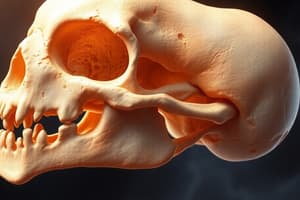Podcast
Questions and Answers
What is the primary component of bone that contributes the least to its composition?
What is the primary component of bone that contributes the least to its composition?
- Inorganic compounds
- Organic compounds
- Water (correct)
- Collagen fibers
Which type of bone is characterized by having a long shaft and two articular surfaces?
Which type of bone is characterized by having a long shaft and two articular surfaces?
- Irregular bone
- Long bone (correct)
- Sesamoid bone
- Flat bone
Which of the following factors is known to negatively influence bone healing?
Which of the following factors is known to negatively influence bone healing?
- Limited movement
- Old age (correct)
- Adequate nutrition
- Pain relief medication
What is the primary function of compact bone?
What is the primary function of compact bone?
Which term describes the process where spongy bone is gradually replaced by lamellar bone during healing?
Which term describes the process where spongy bone is gradually replaced by lamellar bone during healing?
What characterizes irregular bones?
What characterizes irregular bones?
Which condition is characterized by a loss of bone density and strength?
Which condition is characterized by a loss of bone density and strength?
What is the initial response of the bone healing process following a fracture?
What is the initial response of the bone healing process following a fracture?
Which type of osteopathic disease is associated with an infection of the bone?
Which type of osteopathic disease is associated with an infection of the bone?
What is a common result of limited movement around a fracture site during healing?
What is a common result of limited movement around a fracture site during healing?
Flashcards
What is bone?
What is bone?
A hard, living tissue that makes up the skeleton.
What is the composition of bone?
What is the composition of bone?
Bone is composed of 40-50% inorganic compounds (minerals), 30-40% organic compounds (molecules containing carbon), and 20% water.
What are the main components of bone structure?
What are the main components of bone structure?
Osteocytes (bone cells), collagen fibers, and an intracellular matrix containing inorganic salts like calcium and phosphate.
Describe a long bone.
Describe a long bone.
Signup and view all the flashcards
What are sesamoid bones?
What are sesamoid bones?
Signup and view all the flashcards
Describe a flat bone.
Describe a flat bone.
Signup and view all the flashcards
Describe a short bone.
Describe a short bone.
Signup and view all the flashcards
Describe an irregular bone.
Describe an irregular bone.
Signup and view all the flashcards
What is compact bone?
What is compact bone?
Signup and view all the flashcards
What is cancellous bone?
What is cancellous bone?
Signup and view all the flashcards
Study Notes
Bone Composition and Development
- Bone is composed of 40-50% inorganic minerals (e.g., calcium, phosphate), 30-40% organic compounds (e.g., collagen), and 20% water.
- Key structural components include osteocyte cells, collagen fibers, and an intracellular matrix containing inorganic salts.
Bone Types and Locations
- Long bones: Have a diaphysis (shaft) and two articular surfaces (ends), with a central marrow cavity. Examples include the femur and humerus.
- Sesamoid bones: Embedded within tendons, like the patella.
- Flat bones: Thin and often curved, providing protection (e.g., skull bones).
- Short bones: Cube-shaped (e.g., carpals and tarsals).
- Irregular bones: Irregular shapes (e.g., vertebrae).
Bone Tissue Types
- Compact bone: Dense and strong bone tissue forming the outer layer.
- Cancellous (spongy) bone: Porous inner layer with a lattice-like structure, providing strength with less density.
Bone Functions
- Protection: Protecting internal organs.
- Shape: Providing structural support and shape to the body.
- Movement: Providing attachment sites for muscles and enabling joint movement.
- Blood production: Producing red blood cells in bone marrow.
- Mineral storage: Storing calcium and phosphate.
- Sound transmission: Conducting sound waves to the inner ear.
Bone Healing Process
- Primary callus: Fibrocartilaginous callus forms within the first months following a fracture.
- Resorption/Bone formation: Dead bone is removed, and spongy bone formation occurs.
- Callus size: Affected by fracture site immobility; less movement results in a smaller callus.
- Secondary callus: Spongy bone is gradually replaced by stronger lamellar bone, uniting the fracture.
- Remodeling: The bone shape is restored to its original form, a process taking several years.
Factors Affecting Bone Healing
- Delays: Infection, bone fragments, poor blood supply, old age, certain medications (like steroids), and an inadequate host response.
- Improvements: Limited movement, pain relief medication, proper nutrition, age (younger is better), and appropriate guided movement under professional direction.
Common Bone Diseases
- Fractures: Broken bones.
- Osteoporosis: Loss of bone density.
- Osteomyelitis: Bone infection.
- Osteitis: Bone inflammation (e.g., Paget's disease).
- Acromegaly: Overgrowth of bones in face, hands, and feet.
- Fibrous dysplasia: Abnormal bone growth.
- Rickets: Vitamin D deficiency in children.
- Multiple myeloma: Cancer of plasma cells in bone marrow.
- Bone cancer: Cancers originating in bone or spreading to bone from other organs (e.g., osteosarcoma, breast cancer metastasis).
Studying That Suits You
Use AI to generate personalized quizzes and flashcards to suit your learning preferences.


